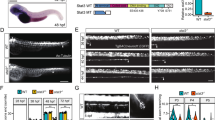Abstract.
The semaphorin family is a large group of proteins controlling cell migration and axonal growth cone guidance. These proteins are bi-functional signals capable of growth promotion or growth inhibition. Initially described in the nervous system, the majority of studies related to semaphorins and semaphorin signalling are nowadays performed in model systems outside the nervous system. Here, we provide an exhaustive review of the many faces of semaphorins both during developmental, regulatory and pathological processes. Indeed, because of their crucial fundamental roles, the semaphorins and their receptors represent important targets for the development of drugs directed at a variety of diseases.
Similar content being viewed by others
Author information
Authors and Affiliations
Corresponding author
Additional information
Received 22 August 2008; received after revision 22 September 2008; accepted 24 September 2008
L. Roth, E. Koncina, S. Satkauskas: These authors contributed equally to this work.
Rights and permissions
About this article
Cite this article
Roth, L., Koncina, E., Satkauskas, S. et al. The many faces of semaphorins: from development to pathology. Cell. Mol. Life Sci. 66, 649 (2009). https://doi.org/10.1007/s00018-008-8518-z
Published:
DOI: https://doi.org/10.1007/s00018-008-8518-z




